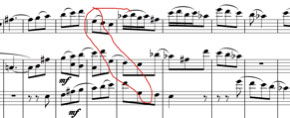Lamenting in a canon
(V3dT4)
By adding several extra imitative voices to the solo passage 'Lament of the shepherd' in the 1st movement of the Summer concerto, Rasmussen limits the agogic freedom of the soloist. The expressive topography of the melodic line is instead locked in a polyphonic canon.

Ex. 1 Enhancing the expressivity of the Lament by adding imitative voices, bb.609-616 (Rasmussen, 2014)
Vid. 1 Lament in a canon. The expressivity of the musical structure vs. expressivity of body movements.
The broken melodic line and chromatic progressions in the bass in Vivaldi’s original Lament invite the soloist to enact the despair of a weeping shepherd in expressive body movements. The melodic patterns attempt to move forward but on each bar line there is a new unexpected dissonance, throwing the melody off its course.

Ex. 2 The initial bars of the Lament in the first movement of the Summer concerto (Vivaldi, 1725).
When the bass finally stops moving, it is too late. The sustained neapolitan harmonic cadential passage comes to a complete halt; each bar takes an eternity, there is nowhere to go. This despair is obviously expressed in the body movements of the soloist.
But in Rasmussen, this is where the other voices join in imitative lines. Rasmussen, as it were, externalizes the despair by enhancing the harmonic complexity of the neapolitan harmony. The shepherd is not alone in his grief, sharing the desperate line with other 'shepherds'. And then, there is no time to indulge in one’s personal grievances, as it needs to be coordinated with three others. So, whether you are desperate or not, you had better watch the conductor!